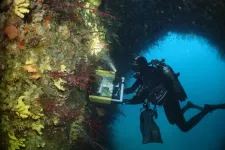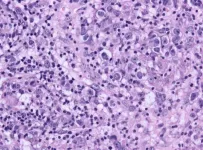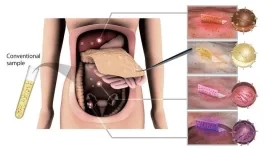(Press-News.org) Under the ocean’s surface, marine organisms are constantly releasing invisible molecules. Some of the chemical clues reveal which creatures are nearby, while others could be used someday as medications. Now, researchers in ACS Central Science report a proof-of-concept device that “sniffs” seawater, trapping dissolved compounds for analyses. The team showed that the system could easily concentrate molecules that are present in underwater caves and holds promise for drug discovery in fragile ecosystems, including coral reefs.
A drop of seawater is like a spoonful of dilute soup: It’s a complex broth of dissolved molecules from ocean-dwelling organisms. And to identify what’s in the mixture, scientists need to capture and concentrate these molecules. Yet, many underwater environments are threatened, especially those with unique — and potentially bioactive — compounds. So, Thierry Pérez, Charlotte Simmler and colleagues wanted to develop an underwater instrument that captures and enriches dissolved compounds produced by sponges or other marine organisms without harming their source and their ecosystem.
The researchers created a waterproof device that could be easily handled by an underwater diver and that could pump seawater through disks, which have a similar feel and thickness as make-up remover pads. These disks adsorbed dissolved molecules for subsequent analysis. They tested the instrument, called the In Situ Marine moleculE Logger or “I-SMEL,” in 65-foot-deep Mediterranean Sea caves that contained a variety of massive sponges. After sampling the water, the researchers assessed the captured compounds with mass spectrometry. The compounds had diverse elemental compositions, and many had molecular structures that are unknown, which the team says makes it promising for the discovery of new natural products.
Several metabolites, including brominated alkaloids and furanoterpenoids, captured from seawater were present in three sponge species that the researchers had examined in detail. And in some cases, the system concentrated compounds released by sponges. For example, aeroplysinin-1 was approximately 20 times more abundant in the extracts from seawater than within a yellow cave-sponge extract. The researchers say that “I-SMEL” represents a non-invasive way to capture molecules of interest to provide insights into an ecosystem’s health or detect novel molecules for future drug discovery efforts. The next step, they add, is to adapt the device for autonomous long-term seawater filtration and remote operation in deeper water.
The authors acknowledge funding from the French National Research Agency; Total Foundation; the Institute of Ecology and Environment from the National Center for Scientific Research for their First Support for Exploratory Projects; the Mission for Transversal and Interdisciplinary Initiatives of the National Center for Scientific Research; and the National Association for Technical Research.
The paper’s abstract will be available on Nov. 8 at 8 a.m. Eastern time here: http://pubs.acs.org/doi/abs/10.1021/10.1021/acscentsci.3c00661
The American Chemical Society (ACS) is a nonprofit organization chartered by the U.S. Congress. ACS’ mission is to advance the broader chemistry enterprise and its practitioners for the benefit of Earth and all its people. The Society is a global leader in promoting excellence in science education and providing access to chemistry-related information and research through its multiple research solutions, peer-reviewed journals, scientific conferences, eBooks and weekly news periodical Chemical & Engineering News. ACS journals are among the most cited, most trusted and most read within the scientific literature; however, ACS itself does not conduct chemical research. As a leader in scientific information solutions, its CAS division partners with global innovators to accelerate breakthroughs by curating, connecting and analyzing the world’s scientific knowledge. ACS’ main offices are in Washington, D.C., and Columbus, Ohio.
To automatically receive news releases from the American Chemical Society, contact newsroom@acs.org.
Follow us: Twitter | Facebook | LinkedIn | Instagram
END
Device 'smells' seawater to discover, detect novel molecules
2023-11-08
ELSE PRESS RELEASES FROM THIS DATE:
A step to prevent opioid overdose deaths with light-activated naloxone treatment
2023-11-08
By rapidly reversing the effects of an opioid overdose, naloxone saves lives ― if it’s available at the right time. To eliminate this element of chance, researchers are exploring ways to have the medication available in the body before it’s needed. In a proof-of-concept in ACS’ Nano Letters, a team has designed injectable nanoparticles that released naloxone when triggered by blue light. In experiments with mice, this system was activated a month after injection.
Since it began more than two decades ago, the opioid epidemic has taken an enormous toll on people’s lives. In 2022 ...
Systemic sclerosis-associated interstitial lung disease focus of latest clinical practice guideline
2023-11-08
In patients with systemic sclerosis (SSc), a rare connective tissue disease, interstitial lung disease contributes to 35 percent of deaths. Published recently in the American Journal of Respiratory and Critical Care Medicine, the latest American Thoracic Society Clinical Practice Guideline makes a number of recommendations. One recommendation expands antifibrotic treatment to all patients with systemic sclerosis associated with ILD (SSc-ILD), not just those with progressive disease.
Watch the explainer video.
Lead guidelines chair and editor, Ganesh Raghu, M.D., ATSF, noted the timeliness of the recommendations given the many immune ...
Study confirms the use of a new biomarker for predicting non-lymphocytic lesions, including germinoma, in patients with central diabetes insipidus
2023-11-08
Central diabetes insipidus (CDI), a rare condition involving the destruction or degeneration of neurons of the hypothalamic-posterior pituitary in the brain, has several likely underlying clinical causes. Patients with CDI experience excessive thirst and excessive urine production, owing to the decreased secretion of AVP. Moreover, in children and young adults with CDI, a malignant tumor known as a 'germinoma' may develop later in life. The diagnosis of these tumors is challenging, because biopsy in intracranial lesions is difficult.
Lymphocytic infundibulo-neurohypophysitis (LINH) or ...
Anesthesia blocks sensation by cutting off communication within the cortex
2023-11-08
General anesthesia evokes a dual mystery: How does it disrupt consciousness, including sensory perception, and what might that say about the nature of consciousness. A new study led by researchers at The Picower Institute for Learning and Memory at MIT provides evidence in animals that consciousness depends on properly synchronized communication across the brain’s cortex and that the anesthetic drug propofol cancels sensory processing by cutting it off.
In the Journal of Cognitive Neuroscience, researchers report clear evidence that in anesthetized animals, ...
Genetics of nearby healthy tissue may help catch lung cancer’s return
2023-11-08
Genetic information collected from seemingly healthy tissue near lung tumors may be a better predictor of whether cancer will come back after treatment than analysis of the tumors themselves, according to new research led by NYU Langone Health and its Perlmutter Cancer Center.
The new study focuses on lung adenocarcinoma, a cancer that forms in alveolar epithelial cells and accounts for about a third of all lung cancers in the United States, according to the U.S. Centers for Disease Control and Prevention. Most patients are cured if tumors are surgically removed early in the disease’s progression, but residual ...
Scientists engineer potent immune cells for ‘off-the-shelf’ cancer immunotherapy
2023-11-08
UCLA scientists have developed a new method to engineer more powerful immune cells that can potentially be used for “off-the-shelf” cell therapy to treat challenging cancers.
“Off-the-shelf” cell therapy, also known as allogenic therapy, uses immune cells derived from healthy donors instead of patients. The approach can bring cell therapies, like chimeric antigen receptor (CAR) T cell therapy, to more patients in a timelier manner, which is one of the major barriers in getting these life-saving treatments to patients.
“Time is often of the essence when it comes to treating people with advanced cancers,” said Lili Yang, associate professor ...
Extracellular vesicles captured using sustainable wood celluose-based nanofiber sheets may identify and improve cancer treatment
2023-11-08
A research team in Japan, led by Nagoya University’s Akira Yokoi, has developed an innovative technique using cellulose nanofiber (CNF) sheets derived from wood cellulose to capture extracellular vesicles (EVs) from fluid samples and even organs during surgery. EVs are small structures from cancerous cells that play a crucial role in cell-to-cell communication. Extracting and analyzing EVs using this new technology has the potential to revolutionize early cancer diagnosis and open the door to personalized medicine. The researchers published their findings in Nature Communications.
Cancer is notorious for its poor prognosis and in many cases goes undetected until its ...
Researchers identify brain network that is uniquely activated through injection vs. oral drug use
2023-11-08
Results from a new clinical trial suggest that a group of brain regions known as the “salience network” is activated after a drug is taken intravenously, but not when that same drug is taken orally. When drugs enter the brain quickly, such as through injection or smoking, they are more addictive than when they enter the brain more slowly, such as when they are taken orally. However, the brain circuits underlying these differences are not well understood. This study offers new information that helps explain what may be causing this difference.
The study was published in Nature Communications and led by researchers at the National Institute on Drug Abuse (NIDA) and the National ...
Genes, cells, and embryos in development and evolution: Pere Alberch, 25 years on
2023-11-08
The last 40 years have witnessed a deep transformation in our views of animal development. From seeing development a multicellular black box where over time a mass of cells acquires shape to form organs and tissues, we now have a detailed account of this process in terms of gene expression, multicellular activity, and morphogenesis.
This new point of view has raised questions about the relationships between genes, cells, and organisms. These questions are impacting our thinking about evolution, ...
Rapid high-dose buprenorphine treatment strategy reduces opioid withdrawal in individuals using fentanyl
2023-11-08
Buprenorphine is a medication approved for pain and opioid dependence. New findings published in The American Journal on Addictions indicate that a transmucosal dose (which dissolves in the mouth) of buprenorphine followed by an injection of extended-release buprenorphine (BUP‐XR) may be an effective treatment for individuals with opioid use disorder who use fentanyl.
The results come from a recent secondary analysis of an open-label study in which 24 participants received a single 4 mg dose of transmucosal buprenorphine followed by an injection ...





